
Now You See It: 5’ x 18” x 2’. Optical sensor, microprocessor, servo motor, tongue depressors, particle board, video camera & display, Stranger exhibit at the CMA Gallery, Seattle WA :: 2003.
This interactive sculpture uses simple technology and materials to play on the viewer’s curiosity to explore the source of light emanating from a hole in the top of a pedestal. The closer the viewer comes to the hole, the more the arm extends, lowering a piece of square, opaque plastic to cover it. The faster the viewer approaches, the faster the arm slaps the plastic over the hole. If, however, the visitor waits for 4 or 5 seconds, the arm will lift to reveal that the light emitting from the hole actually comes from a miniature TV screen. A tiny surveillance camera equipped with infrared lighting is angled so that the patient participant can see an image of their own feet projected on the screen.
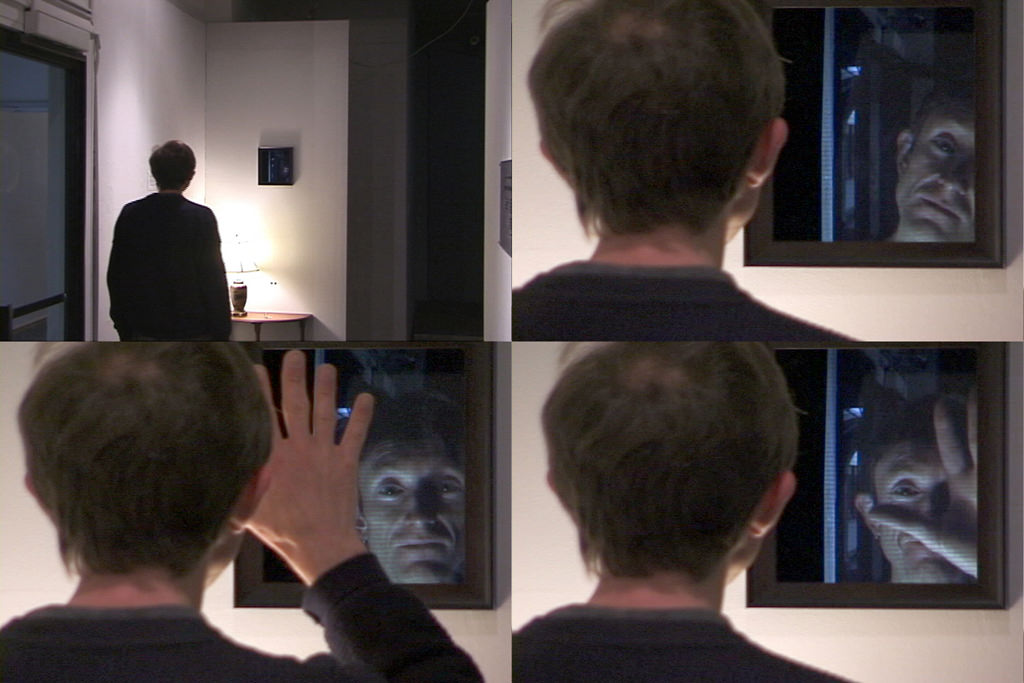
Mirror time: 8’ x 5’ x 3’. Two-way mirror, camera, Tivo, video monitor, sensors, control & feedback system, plywood & gypsum board construction. Part of an exhibit of responsive environments at the Fischer Gallery, Cornish College for the Arts, Seattle, WA:: 2003.
What at first glance appears to be a mirror on a wall catches the viewer by surprise. As they get closer to the mirror, the reflection (which is actually a video image routed through a Tivo) becomes increasingly delayed. Ultimately, within 18”of the mirror there is a 3 second delay, permitting a viewer to turn completely around and then see the back of their own head.
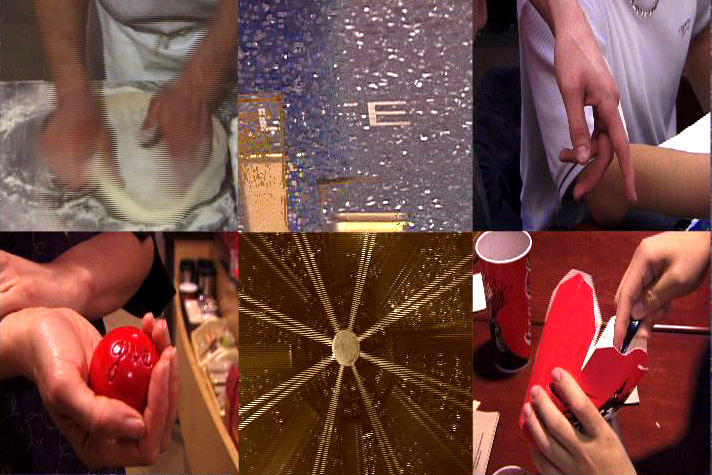
Hand to Hand: Site-specific video and interactive game composite of six images displayed on a 5' x 10' screen. (Collaboration with Timea Tihanyi. Photo Sandor Kovacs), The Hub, University of Washington, Seattle, WA :: 2002.
This 6-channel video focuses on the interactions between people in the Student Union dining area at the University of Washington, and a text inlaid into the floor there that addresses interconnection: "As the spokes of a wheel are connected to the hub, so all things are connected to life". During the performance of the video, game pieces inscribed with the words “give”, “share” and “hold” were handed out, along with a simple set of rules to keep them in motion throughout the space. These tokens reflect those used in parts of the video footage to illustrate transactions involving food, relationship, employment and so on.
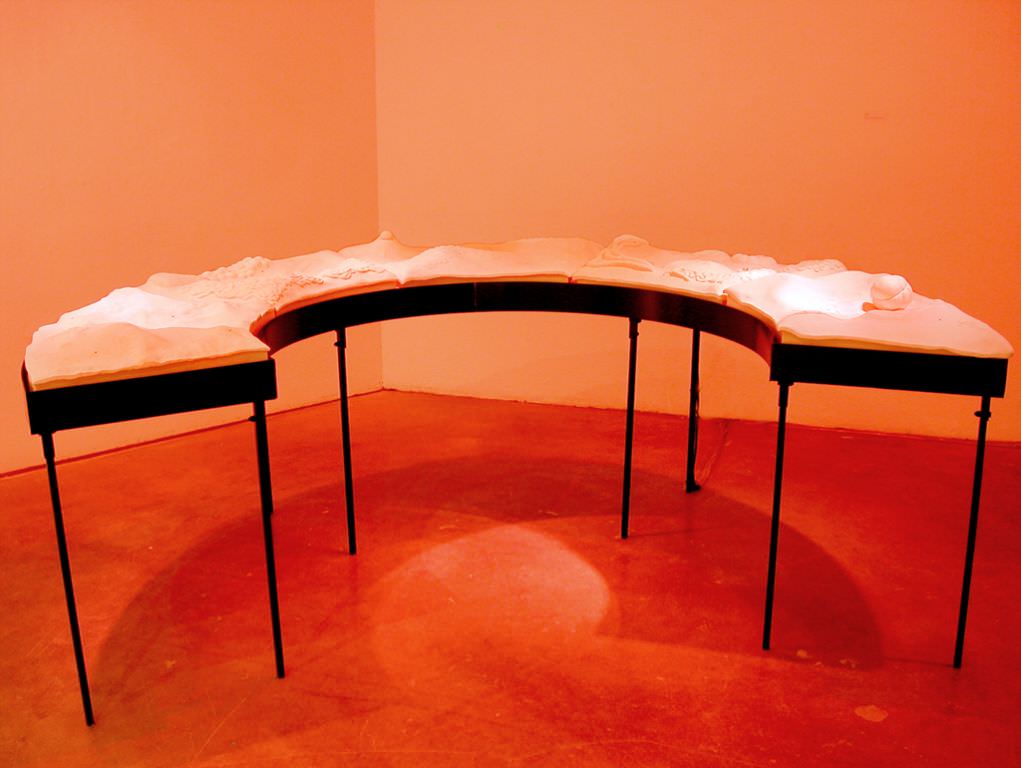
Songlines: 32” x 10’ x 8’ Ceramic, steel, photosensors, heat lamps, sound (56 phonemes of the English language), CMA Gallery, Seattle, WA :: 2003.
This sculpture grew out of a proposition that new kinds of language might be needed in order to be able to think new ideas. By moving a hand over the landscapes, the visitor can find routes to make familiar words, or explore ways to create entirely new ones. The title refers to the way that aboriginal people in Australia map their geography through embodied language. When they journey across the land they reenact the landscape by singing every feature as they travel through it. The sculpture is composed of large clay “tiles” that sit on top of ceramic boxes, all of which rest on a steel frame.
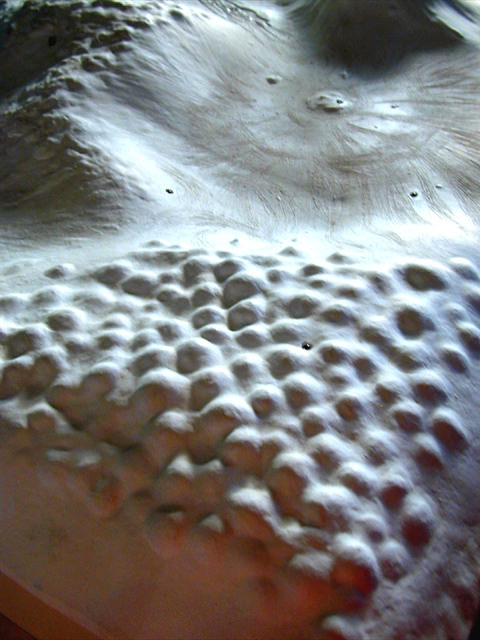
Songlines: detail, Ceramic, steel, photosensors, heat lamps, sound (56 phonemes of the English language), CMA Gallery, Seattle, WA :: 2003.
The textured “landscape” surfaces of the tiles are studded with small infrared photo-sensors, and the room is lit with heat lamps. This means that when a person moves their hand across the sensor, their shadow triggers a response. There are 56 sensors in total, each one of which is linked to a different phoneme (or basic voice sound like “sh” “ch” “a” “oo” and “k”) that we use to speak the English language. The sensors are connected to microprocessors, and these are routed to a computer that plays back pre-recorded sound files. When the sculpture is exhibited, groups of people gather to play it like a collaborative musical instrument.
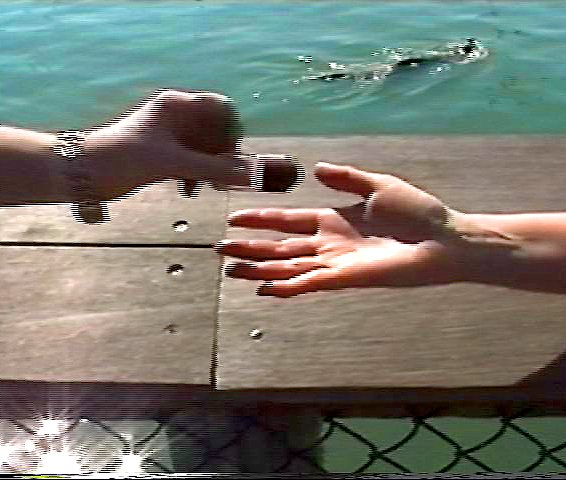
Exchange: Still from video documentation of a performance at Fisherman's Wharf, San Francisco, CA :: 2000.
This performance was prompted by the history of the San Francisco Bay as a seasonal feeding and breeding ground for millions of migrating birds. The site where Fisherman’s Wharf is now located was formerly a marsh teeming with flocks of birds from distant lands, all participating in a tightly woven set of reciprocal relationships with the habitat and all its other life forms. The birds have now been replaced by gaggles of tourists, arriving seasonally and participating in an equally complex set of relationships, now economic rather than ecological in nature.
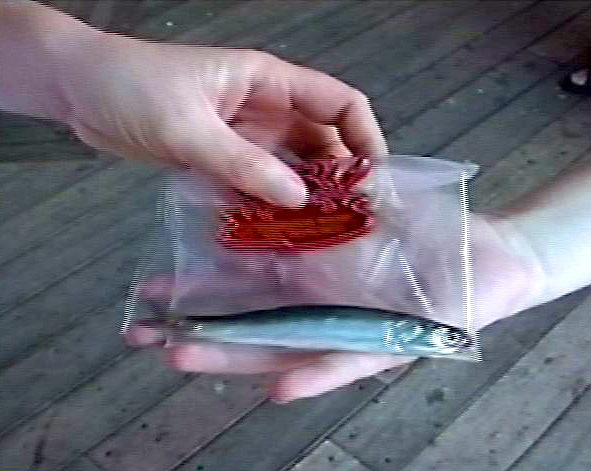
Exchange: Still from video documentation of a performance at Fisherman's Wharf, San Francisco, CA :: 2000.
Tourists were asked if they would be willing to give us something from their pocket or handbag. In return, they received a baitfish from the San Francisco Bay, and a souvenir trinket from the Wharf. The performance became a series of conversations about value.
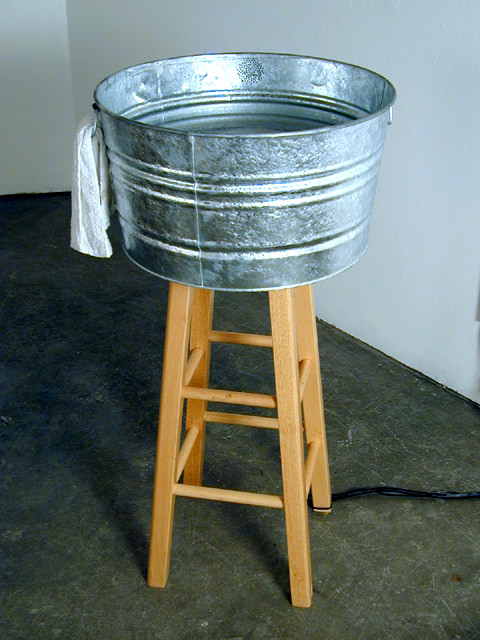
Ablution 20” x 20” x 40”, Galvanized washing tub, water heater, soap suds, towel, photo sensor, video, sound :: 2002.
Visitors drawn to the water by its warmth and fragrant suds, trigger a video loop that is projected onto its surface. This only happens if they put a hand inside the tub, and is a reward of a kind for their willingness to engage.
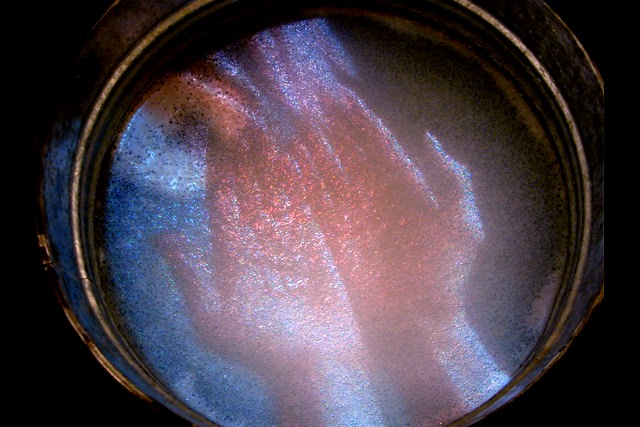
Ablution 20” x 20” x 40”, Galvanized washing tub, water heater, soap suds, towel, photo sensor, video, sound :: 2002.
The image is of one pair of hands tenderly washing text off the palms of another.
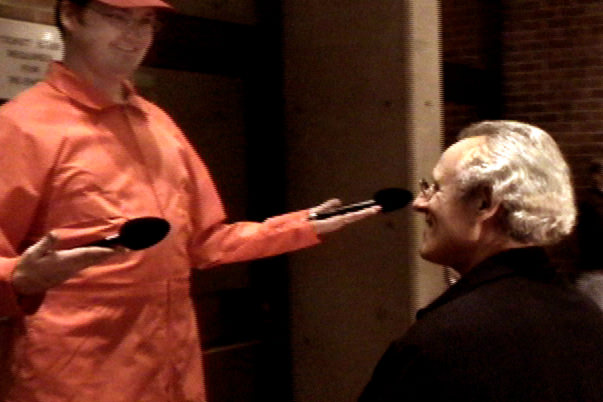
Composite: eight uniformed people, four miniature security cameras, eight LED lanterns, four video mixers, four projectors, plywood and scrim projection booth, microphones, speakers, computer with custom sound mixing software
(Collaboration with Timea Tihanyi, Cris Ewing and Josh Parmenter, performers Eli Rosenblatt, Kris Lyons, Julie Johnson and Peter Mundwiler) Meany Theatre lobby, Seattle, WA :: 2002.
Video still of Cris Ewing collecting a sound sample from conference speaker David Ross. This was an interactive video performance commissioned for an “Experiments in Art and Technology” reunion. The process of collaborative composition included a sound component, in which voice samples were collected in real time from the audience and modified electronically to build a musical score for the event.
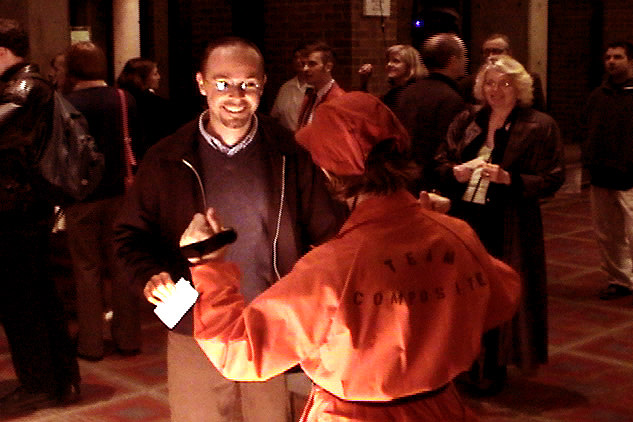
Composite: eight uniformed people, four miniature security cameras, eight LED lanterns, four video mixers, four projectors, plywood and scrim projection booth, microphones, speakers, computer with custom sound mixing software
(Collaboration with Timea Tihanyi, Cris Ewing and Josh Parmenter, performers Eli Rosenblatt, Kris Lyons, Julie Johnson and Peter Mundwiler) Meany Theatre lobby, Seattle, WA :: 2002.
Video still of an audience member interacting with performer Julie Johnson. The performers, wearing small security cameras attached to different parts of their bodies, invited guests to become part of a composite body. We offered a playful allusion to explorations undertaken during the era of EAT, regarding the dynamic, fluid relationships between artist, audience and artwork.
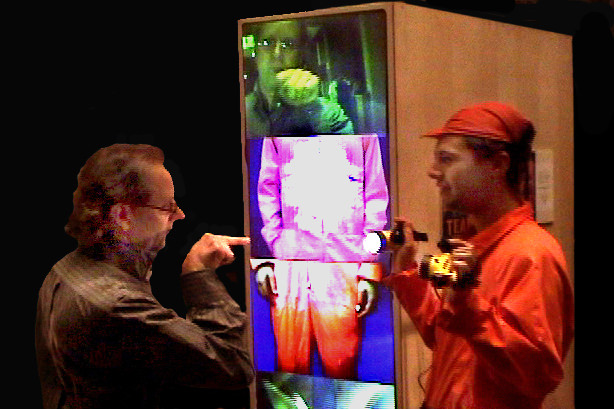
Composite: eight uniformed people, four miniature security cameras, eight LED lanterns, four video mixers, four projectors, plywood and scrim projection booth, microphones, speakers, computer with custom sound mixing software
(Collaboration with Timea Tihanyi, Cris Ewing and Josh Parmenter, performers Eli Rosenblatt, Kris Lyons, Julie Johnson and Peter Mundwiler) Meany Theatre lobby, Seattle, WA:: 2002.
Video still of an audience member interacting with performer Eli Rosenblatt. By mixing between live and pre-recorded footage, body segments of the collaborating artists and performers were virtually and literally displaced by the equivalent segments of participating audience members. By using surveillance technology in a transparent rather than covert manner, we intended to draw a connection between intimate and collective creative experience.
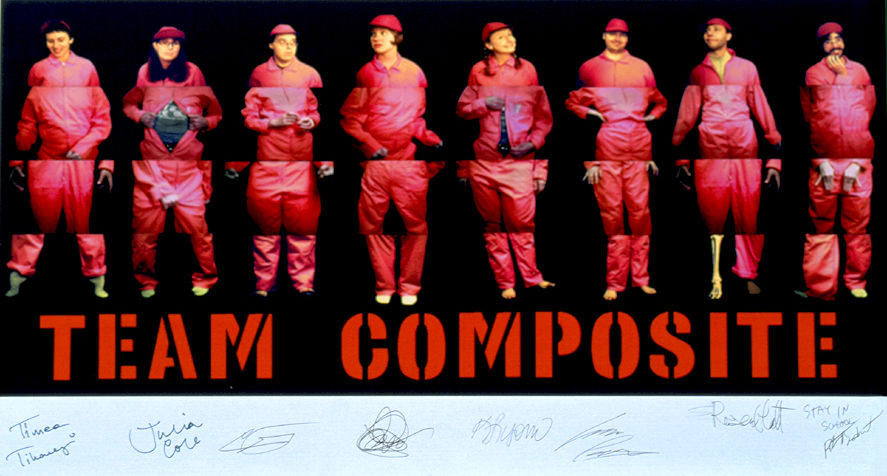
Team Composite:: 2002.
Team poster of the four collaborators and four performers.


